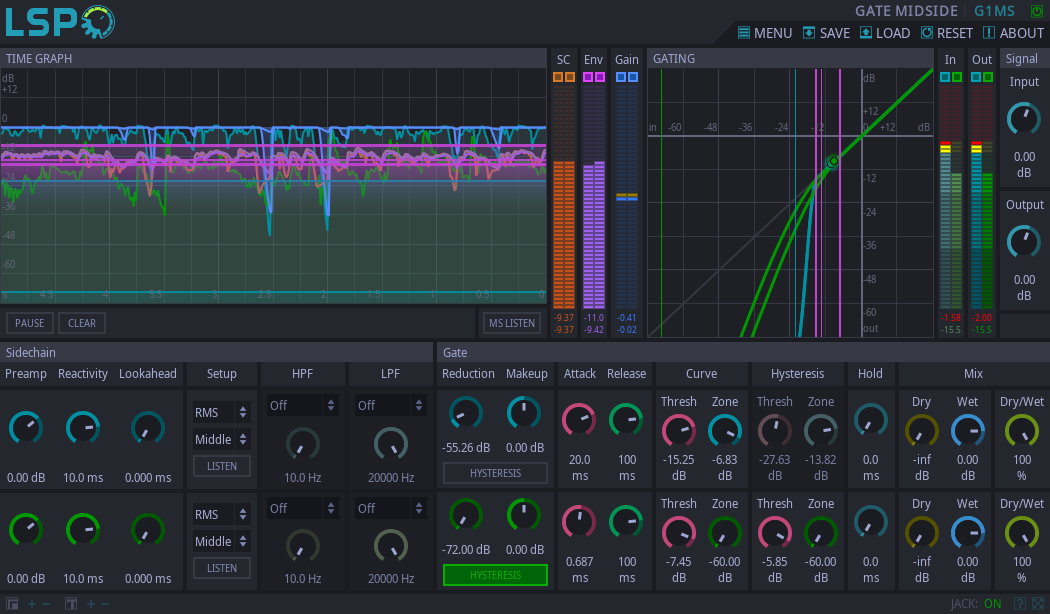Gate MidSide

Detailed: LSP Gate MidSide (G1MS)
Formats: CLAP, JACK, LADSPA, LV2, VST2, VST3
Categories: Gate
Developer: Vladimir Sadovnikov
Description:
This plugin performs gating of stereo input signal in Mid-Side mode. Flexible sidechain-control configuration isprovided. Additional Hysteresis curve is available to provide accurate control of the fading of the signal. Also additional dry/wet control allows to mix processed and unprocessed signal together.
Controls:
- Bypass - bypass switch, when turned on (led indicator is shining), the plugin bypasses signal.
- Pause - pauses any updates of the gate graph.
- Clear - clears all graphs.
- MS Listen - passes mid-side signal to the output of gate instead of stereo signal.
- M/S Link - enables linking between Mid and Side channel controls so change of one forces the sibling to become the same value.
- Gain M, S - enables drawing of gain amplification line and corresponding amplification meter.
- SC M, S - enables drawing of sidechain input graph and corresponding level meter.
- Env M, S - enables drawing of gate's envelope graph and corresponding level meter.
- In M, S - enables drawing of gate's input signal graph and corresponding level meter.
- Out M, S - enables drawing of gate's output signal graph and corresponding level meter.
- Link - the name of the shared memory link to pass sidechain signal.
- Pre-mix - shows pre-mix control overlay.
- Sidechain - shows the sidechain control overlay.
- Mix - shows the Dry/Wet control overlay.
'Gate' section:
- Reduction - the amount of gain applied to the input signal when the gate is closed (if negative) or open (if positive).
- Makeup - additional amplification gain after processing stage.
- Attack - attack time of the gate.
- Release - release time of the gate.
- Curve - Basic gate curve characteristics:
- Thresh - threshold, the level of input signal at which the gate becomes open.
- Zone - the size of the transition zone below the threshold.
- Hysteresis M, S - enables additional hysteresis curve:
- Thresh - threshold (relative to basic curve), the level of input signal at which the gate starts to close.
- Zone - the size of the transition zone below the hysteresis threshold.
- Hold - the time period the envelope holds it's maximum value before starting the release.
'Signal' section:
- Input - overall input gain.
- Output - overall output gain.
Pre-mix control overlay:
- In -> Link - the amount of signal from input channel added to the shared memory link.
- Link -> In - the amount of signal from shared memory link added to the input channel.
- Link -> SC - the amount of signal from shared memory link added to the sidechain channel.
Sidechain control overlay:
- Preamp - pre-amplification of the sidechain signal.
- Reactivity - reactivity of the sidechain signal.
- Lookahead - look-ahead time of the sidechain relative to the input signal.
- Setup - Sidechain configuration, available values:
- Internal - sidechain input is connected to gate's input.
- Link - sidechain input is passed by shared memory link.
- Peak - peak mode.
- RMS - Root Mean Square (SMA) of the input signal.
- LPF - input signal processed by recursive 1-pole Low-Pass Filter (LPF).
- SMA - input signal processed by Simple Moving Average (SMA) filter.
- Middle - middle part of signal is used for sidechain processing.
- Side - side part of signal is used for sidechain processing.
- Left - only left channel is used for sidechain processing.
- Right - only right channel is used for sidechain processing.
- Min - the absolute minimum value is taken from stereo input.
- Max - the absolute maximum value is taken from stereo input.
- Listen - allows to listen the processed sidechain signal.
- LPF - allows to set up slope and cut-off frequency for the low-pass filter applied to sidechain signal.
- HPF - allows to set up slope and cut-off frequency for the high-pass filter applied to sidechain signal.
Dry/Wet mix control overlay:
- Mix Dry - the amount of dry (unprocessed) signal.
- Mix Wet - the amount of wet (processed) signal.
- Mix Dry/Wet - the knob that controls this balance between mixed dry and wet signal (see Mix Dry and Mix Wet) and the dry (unprocessed) signal.































